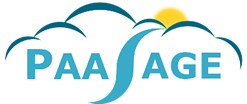D6.1.3 Initial Requirements
Deliverable D6.1.3 Initial-Requirements
This document extends D6.1.1 of the original PaaSage project by describing objectives, requirements and scenarios for the extended eScience case study by AGH and new financial sector by IBSAC, as introduced in the enlarged PaaSage project. The purpose of the document is to describe how the large-size scientific workflows, data farming experiments and financial sector applications will fit into and benefit from the PaaSage framework. The description assumes the current PaaSage architecture based on the deliverables of month 6 and 12 of the project, and presents the case studies in this context. The large-scale scientific workflows will be based on the HyperFlow workflow execution engine developed by AGH....
The planner module of the workflow system will enable to plan workflow execution and prepare an application description in CAMEL together with elasticity rules that will be used by exiting PaaSage components. The application-specific events generated by the running workflow will trigger these autoscaling rules, thus enabling enforcement of the provisioning plan by using the PaaSage platform. The data farming experiments will use the Scalarm, a massively self-scalable platform, which supports all phases of these experiments, using the master-worker design pattern. Scalarm will benefit from the PaaSage platform by the possibility to automatically generate the deployment plan and scaling rules based on the application requirements, as well as by using the multi-cloud infrastructure. The financial sector application will benefit from the multi-cloud methodology and model-driven tools offered by PaaSage, by porting the Windows application to the cloud while preserving key aspects that are crucial for auditing firms, their staff and their clients. These aspects are mainly data security and data confidentiality, rapid elasticity and avoiding cloud vendor lock-in and thus data lock-in. This could be facilitated as follows: the PaaSage Upperware should allow porting the legacy application by defining and designing CAMEL models that capture the requirements and allow configuring the application to be ported to the full-spectrum of the Clouds, while the ExecutionWare should provide platform-specific mapping and technical integration to the APIs of the execution infrastructure of the Cloud providers; e.g. perhaps porting application modules to a public cloud, while porting different copies of the data (e.g. database) on private clouds for added security. In the document, we describe the current status of the use case, and then we describe how the new applications and tools will fit into the PaaSage architecture. Finally, we provide a step-by-step walkthrough PaaSage platform using example deployments and scaling rules.

